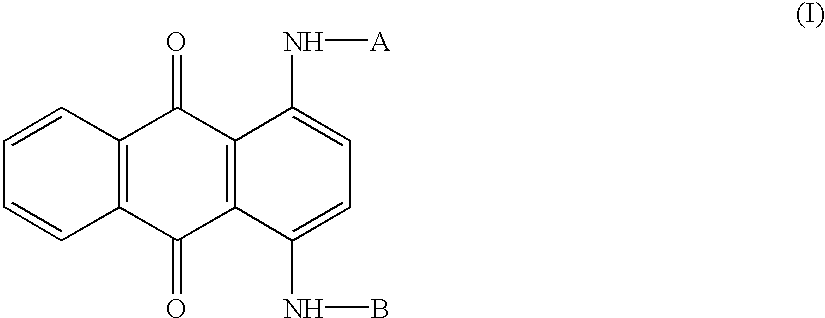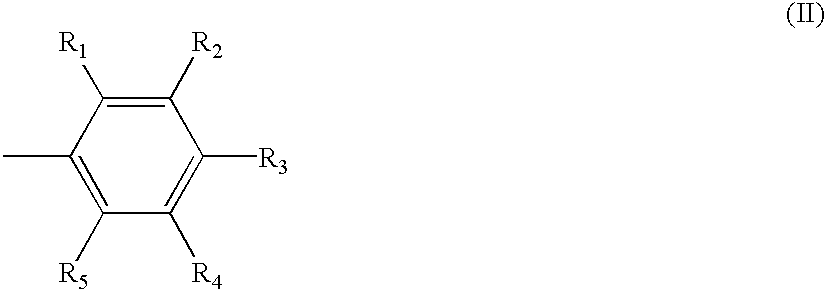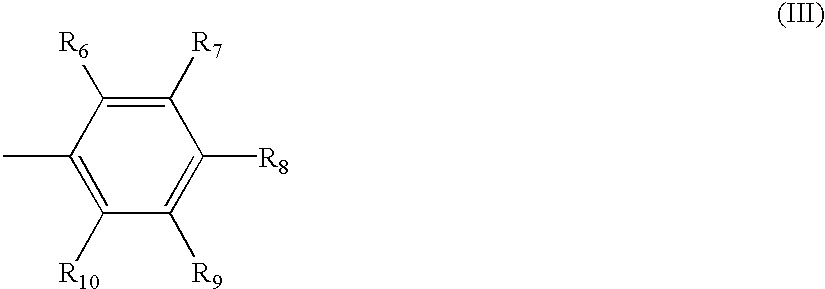Polymeric blue anthraquinone-derivative colorants
a technology of anthraquinone and colorants, applied in the field of polymeric blue anthraquinonederivative colorants, can solve the problems of staining, limited application of such pigments, dyes, dyestuffs as colorants within plastics, and the like, and achieves the effects of reducing the number of stains
- Summary
- Abstract
- Description
- Claims
- Application Information
AI Technical Summary
Benefits of technology
Problems solved by technology
Method used
Image
Examples
example 1
##STR5##
Ethanol (200 proof, 515 g) and p-aminophenol (300 g, 2.75 mol) were charged into a 2L 3-neck round bottom flask equipped with a thermometer and a condenser. Benzaldehyde (292 g, 2.75 mol) was added from an additional funnel while maintaining a slow and steady flow and while stirring. Another portion of ethanol (150 g) was added and the whole mixture was heated to reflux for 1.5 h. After cooling down to room temperature, the solid thus formed was collected by filtration and washed three times with ethanol (3.times.50 ml) and dried. 492 g (91%) of imine product was obtained as a pale yellow powder.
example 2
##STR6##
The imine product (285 g, 1.44 mol, from Example 1) was reacted with 634 g of ethylene oxide in 200 ml of toluene, according to the procedures described in U.S. Pat. No. 5,082,938 and 5,591,833, to yield 910 g (98.2%) of pale brown yellow liquid product.
example 3
##STR7##
The imine product (1182 g, 6 mol, from Example 1) was reacted, according to the procedures described in U.S. Pat. Nos. 5,082,938 and 5,591,833, with ethylene oxide (528 g, 12 mol), propylene oxide (696 g, 12 mol), and ethylene oxide (1056 g, 24 mol), respectively, in 1400 ml of toluene to yield 3360 g (97%) of the product depicted above as a pale brown yellow liquid.
PUM
| Property | Measurement | Unit |
|---|---|---|
| temperature | aaaaa | aaaaa |
| thickness | aaaaa | aaaaa |
| thickness | aaaaa | aaaaa |
Abstract
Description
Claims
Application Information
 Login to View More
Login to View More - R&D
- Intellectual Property
- Life Sciences
- Materials
- Tech Scout
- Unparalleled Data Quality
- Higher Quality Content
- 60% Fewer Hallucinations
Browse by: Latest US Patents, China's latest patents, Technical Efficacy Thesaurus, Application Domain, Technology Topic, Popular Technical Reports.
© 2025 PatSnap. All rights reserved.Legal|Privacy policy|Modern Slavery Act Transparency Statement|Sitemap|About US| Contact US: help@patsnap.com



